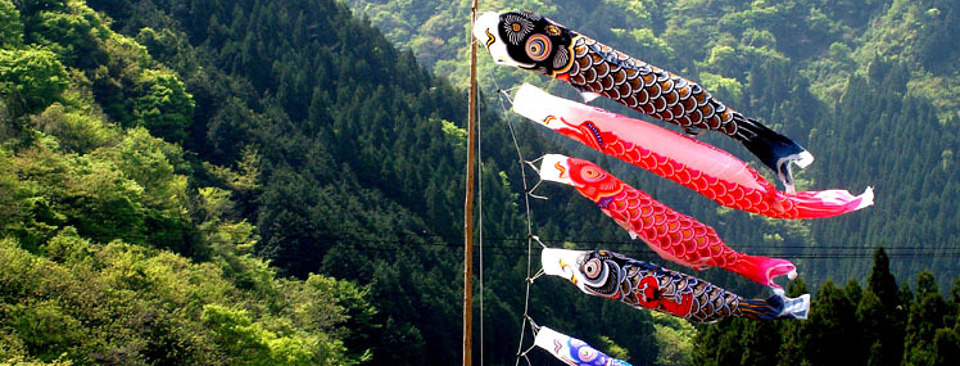Die Bedeutung der Koinobori
Die farbenfrohen koiförmigen Fahnen werden überall in Japan angebracht, wenn der 5. Mai – der Bubentag – näher rückt. Eltern hoffen, dass Ihre Söhne genauso stark und gesund werden wie Koi, die stark genug sind, flussaufwärts zu schwimmen und Wasserfälle hinunter zu stürzen. Ein Set aus Fahnen besteht normalerweise aus einer Dekorationsfahne (die wir Wind-Flair™ nennen) und drei oder mehr Koi (die wir Wind-Koi® nennen).
Der große schwarze (magoi) stellt den Vater dar. Laut eines japanischen Kinderliedes stellt der rote den erstgeborenen Sohn dar, im modernen Japan jedoch sehen ihn viele lieber repräsentativ für die Mutter. Die kleineren (normalerweise grün und blau) stehen für die anderen Söhne der Familie. Immer wenn ein Sohn geboren wird, kommt ein WIND-KOI® hinzu.
Der schwarze Koi ist der größte. In einem normalen Familien-Set ist er ca. 1,5 m lang. Allerdings kann er auch bis zu 10 m Länge haben. Diese hängen oft an großen Gebäuden oder Brücken, um den Bubentag zu feiern. Die ganz kleinen werden als Spielzeug oder Souvenirs verkauft.
Die Fahnen gibt es aus unterschiedlichen Stoffen und somit Preisen. Die gängigsten werden aus einem sehr haltbaren Material wie beispielsweise Polyester gefertigt. Ein gutes Set kann um die €500 kosten. Daneben gibt es auch handgefertigte WIND-KOI® die dann bis zu € 2000 kosten können. Traditionell werden diese per Hand bemalt oder mit Gold auf reiner Seide bedruckt.
Traditionell schenken die Großeltern nach der Geburt des ersten Sohnes den Eltern ein Set der WIND-KOI®. Diese sind meist aus guter Qualität, um sie jedes Jahr wieder verwenden zu können.
Cultural Meaning
Everywhere in Japan the colorful koi flags are displayed as Boy's Day on the fifth of May draws closer. The koi is believed to be a lucky fish symbolizing success in life. And so Japanese parents fly the KOINOBORI wishing for good health and growth for their sons and hoping that they will grow up as strong and healthy as the koi. These fish are strong enough to swim upstream and plunge under waterfalls. There is a historical allusion of koi going up a waterfall. It started in an old story. There was once upon a time a waterfall called the "Gate of the Dragon". All kinds of fish tried to go up it. Allmost all of them failed, but a few succeeded, transforming themselves into dragons. These were the koi. Therefore koi represent success and outstanding people.
Usually a set of flags consists of one decorative flag (which we call Wind-FlairTM) and three or more koi (which we call Wind-Koi®). The large black "magoi" represents the father. According to a Japanese children's song the red koi represents the first-born son, however, in modern Japanese culture, many believe the red one to be representative of the mother. The smaller koi (usually green and blue) stand for the other sons in the family. As another son is born in the family a new WIND-KOI® is flown.
The black koi is the largest and in a usual "family set" it is about 1,5 m (5 ft.) in lenth. However, it can be up to 10 m (30 ft.) long. These flags are often found hanging from tall buildings or bridges during the Boy's Day holiday. The smallest are sold as either toys or souvenirs.
The flags come in various types of cloth and the price varies depending on the material used. The most common are made from a durable polyester. A good set costs around € 500 ($ 620). In addition handstitched WIND-KOI® are available which can cost up to € 2000 ($ 2400). Tradionally, these flags are painted by hand or their designs are printed in gold on pure silk.
It is traditional for Japanese grandparents to give a set of WIND-KOI® to the parents after the birth of the first-born son. This set consists of flags out of the best materials so it can be used over and over again each year. Families who live in a house with garden set up a tall pole with WIND-KOI®, others who live in an apartment hang smaller ones with a stick on their veranda.
The tradition of WIND-KOI® in Japan goes way back in history. It is told that the samurais of the edo-perios (1603-1868) produced the first WIND-KOI® to ensure their sons' good growth and success. This custom became popular among the common people. Ever since the koi is the symbol for health and is often used as a design motife.
These days you can find Koinobori all over the world. Their usages are different from the Japanese one. They are used for interior decoration, mark of yacht harbor or signboard of Japanese restaurants. You may find Koinobori somewhere unexpected in the world.







